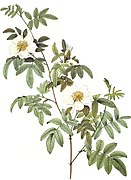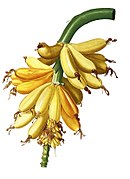Pierre-Joseph Redouté
This articleneeds additional citations forverification.(July 2010) |
Pierre-Joseph Redouté | |
|---|---|
 Portrait byLouis Léopold Boilly | |
| Born | 10 July 1759 |
| Died | 19 June 1840(aged 80) Paris,France |
| Resting place | Père Lachaise Cemetery |
| Nationality | Belgian |
| Education | Jardin du Roi |
| Known for | Botanical illustration |
| Movement | Flower painting |
| Awards | Chevalier of theLégion d'honneur(1825) |
Pierre-Joseph Redouté(French pronunciation:[pjɛʁʒozɛfʁədute],10 July 1759 – 19 June 1840), was apainterandbotanistfrom the Austrian Netherlands, known for hiswatercoloursofroses,liliesand other flowers at theChâteau de Malmaison,many of which were published as large coloured stipple engravings.[1]He was nicknamed "theRaphaelof flowers "and has been called the greatest botanical illustrator of all time.[2]
Redouté was an official court artist ofMarie Antoinette,and continued painting through theFrench RevolutionandReign of Terror.He survived the turbulent political upheaval to gain international recognition for his precise renderings of plants, which remain as fresh in the early 21st century as when first painted. He combined great artistic skills with a pleasing and ingratiating personality which assisted him with his influential patrons. After Queen Marie-Antoinette, his patrons included both of Napoleon's wives –Empress JoséphineandMarie Louise, Duchess of Parma– as well asMaria Amalia of Naples and Sicily,wife ofLouis Philippe I,the last king of France.[1]
Redouté collaborated with the greatest botanists of his day and participated in nearly fifty publications depicting both the familiar flowers of the French court and plants from places as distant as Japan, America, South Africa, and Australia. He worked from live plants rather thanherbariumspecimens, which contributed to his fresh subtle renderings. He was painting during a period inbotanical illustration(1798 – 1837) that is noted for the publication of outstandingfolioeditions with colouredplates.Redouté produced over 2,100 published plates depicting over 1,800 differentspecies,many never rendered before. Of the French botanical illustrators employed in the French capital, Redouté is the one who remains in the public consciousness today.[1]He is seen as an important heir to the tradition of theFlemishandDutchflower paintersBrueghel,Ruysch,van Huysumandde Heem.
Early life[edit]

Redouté was born 10 July 1759, inSaint-Hubert,in theBelgianLuxembourg.Both his father and grandfather were painters, and his elder brother, Antoine Ferdinand, was an interior decorator and scenery designer. He never had much in the way of formal education, instead leaving home at the age of 13 to earn his living as an itinerant painter, doing interior decoration, portraits, and religious commissions. Eventually, in 1782, he made his way to Paris to join his brother in painting scenery for theatres.
Painting career[edit]
In Paris, Redouté met the botanistsCharles Louis L'Héritier de BrutelleandRené Desfontaines,who steered him towards botanical illustration, a rapidly growing discipline. L'Héritier became his instructor, teaching him to dissect flowers and portray their specific characteristics with precision. L'Heritier also introduced Redouté to members of the court atVersailles,following which Marie Antoinette became his patron. Redouté eventually received the title of Draughtsman and Painter to the Queen's Cabinet.

Cheveau, a Parisian dealer, brought the young artist to the attention of the botanical artistGerard van Spaendonckat theJardin du Roi,which became theJardin des plantesof theNational Museum of Natural History, Francein 1793, after the Revolution. Van Spaendonck became another of Redouté's teachers, especially influencing his handling of watercolour.
In 1786, Redouté began to work at the National Museum of Natural History cataloguing the collections of flora and fauna and participating in botanical expeditions. In 1787, he left France to study plants at theRoyal Botanic Gardens, Kewnear London, returning the following year. In 1792 he was employed by theFrench Academy of Sciences.In 1798, EmpressJoséphine de Beauharnais,the first wife ofNapoleon Bonaparte,became his patron and, some years later, he became her official artist. In 1809, Redouté taught painting toPrincess Adélaïde of Orléans.[3]
Redouté was engaged to paint selected plants from the garden at theChâteau de Malmaison,Paris. Whilst he was well known for the paintingLes Roses,Jardin de la Malmaisonhas a distinctly Australian connection, as 46 of the 120 plates featured Australian plants, and the majority of these are endemic toQueensland.[4]One of the first Australian plants Empress Joséphine chose for Redouté to illustrate was a common Queensland flowering vine,Hardenbergia violacea(false sarsaparilla), a vine seen in abundance in the Queensland bush. Other Queensland plants illustrated include thePandorea pandorana(wonga wonga vine),Melaleuca styphelioides(prickly-leaved paperbark), andHibiscus heterophyllus(native rosella).[4]
Later career and legacy[edit]


After Empress Joséphine's death (1814), Redouté had some difficult years until he was appointed a master of draughtsmanship for the National Museum of Natural History in 1822. In 1824, he gave some drawing classes at the museum. Many of his pupils were aristocrats or royalty. He became aChevalier of the Legion of Honourin 1825. Although particularly renowned for his botanical exploration of roses and lilies, he thereafter produced paintings purely for aesthetic value.[5]
Redouté taught and painted up to the day he died of a stroke on 19 or 20 June 1840.[6]He was survived by his wife, Marie-Marte Gobert, whom he married in 1786, and their two daughters.[6]He was interred inPère Lachaise Cemetery.ABrusselsschool bears his name: theInstitut Redouté-PeifferinAnderlecht.
Most of theLes Liliacéeswatercolours went from the Empress Joséphine to her son from her first marriageEugène de Beauharnais.Most of the watercolours of herJardin de la Malmaison(gardens ofChâteau de Malmaison) were acquired by theFitzwilliam Museumin Cambridge.[6]
Redouté's paintings forLes Roseswere bought byCharles X of Francefor his widowed daughter-in-law,Marie-Caroline of Bourbon-Two Sicilies, Duchess of Berry.Their whereabouts are virtually untraceable: in 1948 some were sold bySotheby'sin London and a few were acquired by the Hunt Institute for Botanical Documentation; later, single sheets have appeared repeatedly in auction.[6]
In 1985, 468 leaves were bought at a New York auction by an art dealer for approximately $5.5 million and then dispersed.[6]
In the 20th and 21st century, numerous exhibitions in Europe, the Americas, and Australia have been devoted to the work of Redouté. TheBiodiversity Heritage Library,theLibrary of Congressand other libraries have made many of his works accessible online[6]and reproductions of his prints are available from virtually all print and poster shops.
Principal works[edit]
- Geraniologia,,ed. Petri-Francisci Didot (1787–88)
- Traité des arbres et arbustes que l'on cultive en France, par Duhamel. Nouvelle édition, avec des figures, d'après les dessins de P. J. Redouté,7 vols. (1800–1819)
- Les Liliacées,8 vols. (1802–1816);TaschenAmerica (2000)ISBN3-8228-6407-2;SCD, University of Strasbourg. (1802–1816) On line.
- Les Roses,3 vols. (1817–1824); French & European Pubns (1954)ISBN0-320-05904-9;Pierre-Joseph Redoute, Sandra Raphael (Narrator), Ian Jackson (Translator), CD-ROM Octavo (2002)ISBN1-891788-28-0;NYPL On Line.orRare Book Room(1817–1824 from Library of Congress) orRare Book Room(1817 from The Warnock Library). Taschen has also published this as part of its 25th Anniversary series.
- Redouté, Pierre-Joseph; with Candolle, Augustin Pyramus (1790).Plantes grasses.Levrault. Archived fromthe originalon 6 December 2008.
- Choix des plus belles fleurs et de quelques branches des plus beaux fruits.Dédié à LL. AA. RR. les princesses Louise et Marie d'Orléans(1827)Online facsimile - Biodiversity Heritage Library
- Catalogue de 486 liliacées et de 168 roses peintes par P.-J. Redouté(1829)
- Alphabet Flore(1835)
Posthumously published, in 1989:
- Champignons du Luxembourg. Planches inédites de Pierre-Joseph Redouté (1759–1840). Manuscrit deLouis Marchand(1807–1843).Ministère d'Etat. Government commission for the commemoration of the 150th anniversary of Independence of the Grand Duchy of Luxembourg; Musée national d'histoire naturelle; Société des naturalistes luxembourgeois, 1989.
Paintings[edit]
-
Rosa centifolia(cabbage rose)
-
Rosa moschata(musk rose)
-
Fritillaria imperialis
-
Musa × paradisiaca
Sources[edit]
- "Redouté, Pierre-Joseph".SCD, Universities of Strasbourg. Archived fromthe originalon 11 December 2007.
- Redouté, Pierre-Joseph; Raphael, Sandra (narrator); Jackson, Ian (translator) (2004) [1827–1833].Choix des Plus Belles Fleurs.Paris: California Academy of Sciences / Octavo.ISBN1-59110-053-4.
{{cite book}}:|first3=has generic name (help)[8] - Musée de la Vie romantique (Paris) (2017).Le Pouvoir des fleurs: Pierre-Joseph Redouté (1759-1840)(in French). Paris: Paris Musées.ISBN978-2-7596-0345-9..This is the catalog of the exhibition at the Musée de la vie romantique in Paris, April 28 to October 1, 2017.
References[edit]
- ^abcLack, H. Walter (2018).Redoute: The Book of Flowers.Germany: TASCHEN. pp. 8 & 9.ISBN978-3836568937.
- ^Schmidt, Alesandra M., and Trudy B. Jacoby."Herbs to Orchids: Botanical Illustration in the Nineteenth Century".Watkinson Exhibition Catalogs, Paper 3, 1996.
- ^"Princesse Louise Marie Eugénie Adélaïde d'Orléans (1777–1847)".John Mitchell Fine Paintings.
- ^ab
 This Wikipedia article incorporates text fromJardin de la Malmaison: The French and Australian plants(29 September 2022) by Stacey Larner published by theState Library of QueenslandunderCC BYlicence,accessed on 18 January 2023.
This Wikipedia article incorporates text fromJardin de la Malmaison: The French and Australian plants(29 September 2022) by Stacey Larner published by theState Library of QueenslandunderCC BYlicence,accessed on 18 January 2023.
- ^cdpb.
- ^abcdefLack, H. Walter (2018).Redoute: The Book of Flowers.Germany: TASCHEN. p. 14.ISBN978-3836568937.
- ^International Plant Names Index.Redouté.
- ^Taschen was due to release its version of this book on 1 October 2009;Rare Book Room On Line
Literature[edit]
- Blunt, Wilfrid; Stearn, William T. (1950). "The Art of Botanical Illustration".The Age of Redouté.London:Collins.pp. 173–183.ISBN0-486-27265-6.
- Dierkens, Alain;Lawalrée, Andre;Duvosquel, Jean-Marie (1996).Pierre-Joseph Redouté, 1759–1840: La Famille, L'Oeuvre,( "Pierre-Joseph Redouté, 1759–150: his life and works" ).Saint-Hubert, Belgium: Centre Pierre-Joseph Redouté.ISBN2-87193-238-7.
- Redouté, Pierre-Joseph."Choix des Plus Belles Fleurs".Octavo Editions. Archived fromthe originalon 5 August 2010.Retrieved27 July2010.CD-ROM
- Ridge, Antonia(1974).The Man Who Painted Roses: Story of Pierre-Joseph Redoute.Faber and Faber.ISBN978-0571105540.
External links[edit]
- (in English)"Pierre Joseph Redouté" biography at globalgallery.
- (in English)"Pierre-Joseph Redouté, 1759-1840",From Seed to Flower: Selected Books from the Cornelius J. Hauck Botanical Collection,Cincinnati Museum.
- (in French)Drawings of roses by Pierre-Joseph Redouté at the University of Liège
- (in English)Drawings of roses by Pierre-Joseph Redouté at rosarian
- (in French)Redouté in the cultural history of Wallonia at wallonie-en-ligne.net
- (in French)Dictionary of Belgian painters at balat.kikirpa.be
- Les roses, par P.J. RedoutéFrom the Collections at theLibrary of Congress
- Botanical illustrations by Pierre Joseph Redouté at RHS Digital Collections
- Botanical illustrations ofPierre Joseph Redouté.athttp:// plantillustrations.org





